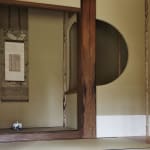Attributed to Prince Munetaka
Arisugawa-gire, a Fragment from the Waka Poem Anthology Man’yōshū
Ink on paper, hanging scroll
With box authentication by Tayama Honan (1903−1980), double boxed
24.1 x 16.1 cm
140 x 39 cm (overall)
With box authentication by Tayama Honan (1903−1980), double boxed
24.1 x 16.1 cm
140 x 39 cm (overall)
Further images
Provenance
Collection of the Mitsui familyLiterature
Komatsu, Shigemi ed. Kohitsugaku taisei vol. 12. Tokyo: Kodansha, 1990.
This is a fragment from volume 12, Genryaku kohon Manyoshu, the manuscript of the poem anthology Manyoshu, dated the first year of Genryaku era (1184) in the postscript of volume 20. This Genryaku kohon version is recognized as one of the “Five Great Manyoshu”, together with Katsuranomiya, Ranshi, Kanazawa, and Tenji versions. This version is considered of particular importance, for its abundancy in poems, as well as the involvement of a great many masterly calligraphers at the time. The fragments of this version are usually addressed as the Arisugawa-gire, or Arisugawa fragments, for its distinguished provenance of the Prince of Arisugawa family.
The present fragment writes a mondoka, or dialogue poem, in manyogana and hiragana scripts, on torinoko washi paper decorated with purple and indigo-dyed cloud-like patterns and ink borders. It was considered to be executed some years before the first year of Genryaku (1184). Its gracious writing style displays a variety of rhythms in scripts, and was attributed to Prince Munetaka, who is known for waka composition and calligraphy. Although its calligrapher remains unknown, he must be an established one in the late twelfth century. Moreover, this fragment is mounted against a Chinese cloth with embroideries of flower and bird and a Taihu rock, which is reminiscent of the Yorakuin (Konoe Iehiro) mounting style. Its flamboyant yet calm air adds to the flavor of the whole work.
Prince Munetaka (waka poet; 1242–1274)
Mid-Kamakura period prince and the sixth shogun of the Kamakura shogunate. Born to Gosaga Emperor and Jusangu Taira no Muneko as the emperor’s second son. Became an adopted son of Gofukakusa Emperor. His Buddhist names are Gyosho and Kakue. The first imperial member to be nominated a shogun by the Kamakura shogunate. Exceled at waka writing. Composed personal waka collections such as Shoshin Guso, Ryuyo wakashu, and Keigyoku wakashu. Sixty-seven waka of his were included in the waka collection Shoku Kokinshu.
The present fragment writes a mondoka, or dialogue poem, in manyogana and hiragana scripts, on torinoko washi paper decorated with purple and indigo-dyed cloud-like patterns and ink borders. It was considered to be executed some years before the first year of Genryaku (1184). Its gracious writing style displays a variety of rhythms in scripts, and was attributed to Prince Munetaka, who is known for waka composition and calligraphy. Although its calligrapher remains unknown, he must be an established one in the late twelfth century. Moreover, this fragment is mounted against a Chinese cloth with embroideries of flower and bird and a Taihu rock, which is reminiscent of the Yorakuin (Konoe Iehiro) mounting style. Its flamboyant yet calm air adds to the flavor of the whole work.
Prince Munetaka (waka poet; 1242–1274)
Mid-Kamakura period prince and the sixth shogun of the Kamakura shogunate. Born to Gosaga Emperor and Jusangu Taira no Muneko as the emperor’s second son. Became an adopted son of Gofukakusa Emperor. His Buddhist names are Gyosho and Kakue. The first imperial member to be nominated a shogun by the Kamakura shogunate. Exceled at waka writing. Composed personal waka collections such as Shoshin Guso, Ryuyo wakashu, and Keigyoku wakashu. Sixty-seven waka of his were included in the waka collection Shoku Kokinshu.









